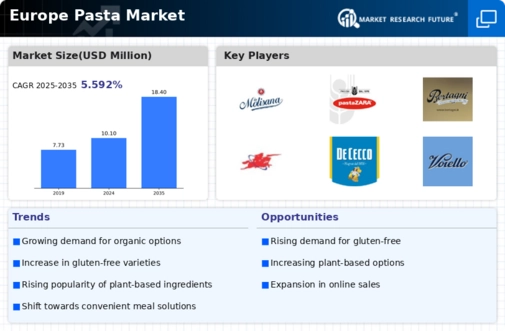The Europe Pasta Market has been witnessing significant growth due to the rising demand for convenient and ready-to-eat meals among consumers. This market is characterized by a diverse range of products that cater to various consumer preferences, including whole grain, gluten-free, and organic pasta options.
A number of key players compete for market share, employing strategies such as product innovation, promotional campaigns, and strategic partnerships to enhance their presence. The competition is intensified by the increasing health consciousness among consumers, leading to a preference for pasta made from healthier ingredients and the trend towards vegetarian and vegan diets.
Furthermore, the growing popularity of Italian cuisine across Europe continually drives the demand for pasta, presenting opportunities for brands to expand their offerings and build strong loyalty among customers.
Galbani has established a strong foothold within the Europe Pasta Market, leveraging its extensive experience in food production that spans more than a century. The company's commitment to quality and heritage resonates well with European consumers, as it emphasizes traditional Italian recipes and premium ingredients.
Galbani's strengths lie in its brand recognition and a comprehensive portfolio of pasta products, which includes a range of dried and fresh pasta options that appeal to various demographic segments. In addition to maintaining a solid distribution network, Galbani frequently innovates its product offerings, ensuring they align with evolving consumer preferences and dietary requirements.
This adaptability enables Galbani to effectively compete with other major players in the market while reinforcing its position as a trusted brand within the pasta segment.
La Molisana is another prominent player in the Europe Pasta Market, known for its high-quality products that resonate with consumers looking for authentic Italian pasta. The company's product portfolio includes a wide selection of pasta shapes and types, all crafted with carefully sourced ingredients that reflect traditional manufacturing methods.
La Molisana has a notable presence in both retail and food service sectors, allowing it to reach a diverse customer base. The strength of the brand lies in its dedication to quality, which is bolstered by key investments in sustainable practices and innovation in production techniques.
In recent years, La Molisana has also pursued mergers and acquisitions to enhance its market presence and capabilities in Europe, allowing it to broaden its distribution channels while further solidifying its brand standing in a competitive marketplace.























Leave a Comment